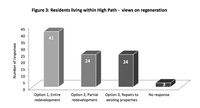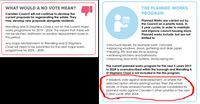
Ballots
Why the ballot process is flawed
Ballots came about in 2018 through campaigning that led to the publication of the Mayor of London’s Good Practice Guide to Estate Regeneration.
Around half of London's estates under threat (51 estates) were exempted from the ballot requirement by the Mayor, on the basis that they had already been allocated funding (even if many of these funding agreements have since expired). This includes many of the largest estates like the Aylesbury, South Acton and Grahame Park estates.

The remainder require a positive ballot if they want to receive Mayoral funding.
Most of the ballots that have taken place have resulted in residents voting in favour of demolition, but there are a number of problems with the ballot process:
The issues
The main problems are as follows:
-
Ballots are being avoided altogether by schemes circumventing the requirement by not applying for Mayoral funding (see Ebury Bridge estate, the Cundy Street estate and the Alton estate.
-
Ballots are being repeated after a NO vote until a positive ballot is obtained. See for example the Juniper Crescent and Gilbeys Yard estate.
-
Temporary tenants, intermediate rent tenants and private rented sector tenants are excluded from being able to take part in ballots unless they have been on the Council's housing waiting list for at least one year.
-
Significant resources are being allocated to YES vote campaigns while NO vote campaigns are entirely unfunded. In January 2022, it was revealed that Haringey Council spent a staggering £350k on its campaign for a YES vote in the Love Lane estate ballot.
-
Estates are being decanted well ahead of any ballot such that the majority of residents at the time of a ballot are temporary tenants, who are incentivised to vote YES on the promise of a secure tenancy. For example, temporary tenants numbered 226 on the Love Lane estate, compared with 43 secure tenants and 25 resident leaseholders. These were offered secure tenancies at social rents if they vote in favour of redevelopment. Note that temporary tenants usually pay much higher rents than secure tenants.
-
Residents are faced with a choice of redevelopment or continued decline in living conditions - refurbishment is never offered as an option on the ballot paper. ballot Landlord Offers routinely make it clear that if residents vote NO then their estates will receive only essential maintenance. They are also sometimes told that if they vote against the plans they will be subject to some kind of in-fill plans or rooftop homes being built on top of them. See some examples of this here.
-
The majority of ballot Landlord Offers fail to comply with the Mayor's requirement to provide details of the proposed tenure mix. For those offers that do, in some cases the tenure mix is watered down later on as schemes enter the planning process - see the High Lane estate and the Geoffrey Close estate as examples of this. In both cases the proportion of social rented housing was reduced from the levels proposed in the ballot Landlord Offer. This raises the broader issue of remedy in that ballot Landlord Offers are not legally binding and there is no recourse if Landlords fail to honour promises set out in the Landlord Offer. The Mayor has the power to withdraw his funding but in both of the above cases he decided not to do so.
-
The majority of ballot Landlord Offers fail to provide detailed information about shared equity or equity loan schemes to leaseholders. For example the Broadwater Farm Offer simply says that leaseholders will be offered 'equity loans of up to 40% of your new property'. It provides no details of the equity loan scheme whatsoever. A closer look at the small print in the Council's policy shows that leaseholders are required to take up a second mortgage in order to qualify for the scheme, there is an arbitrary cap on the maximum value of the replacement property and they will not be able to pass on their home to their children unless they have fully staircased - i.e. bought out the Council's share. These were all small print caveats that leaseholders on the Aylesbury estate successfully challenged, as well as increasing the maximum equity loan to 75% rather than the 40% in this instance.
NB. a 'ballot offer' is the formal Landlord Offer document which is provided to residents at the time of the ballot, which explains the redevelopment proposals that residents will vote to approve or reject.
Residents from London's estates under threat have been participating in our regular Estate Watch meetings and sharing their stories of ballot experiences on their estates. The following case studies give a number of examples of what residents said.
Case studies
Achilles Street estate, Lewisham
Lewisham Council spent a lot of money in the lead-up to the ballot. This included refurbishment of the tenants’ hall (which had been previously unused for 14 years) for the ouncil and consultants to make themselves visible on the estate, for about 4 months prior to he ballot. The cost of the refurbishment £21,272 and of employing ‘Studio Raw’ (design tudio) was £30,915.
Consultants carried out door knocking in groups, sometimes accompanied by Councillors. They made requests to enter residents’ homes to speak to them face to face. They old people that the Achilles campaign was lying, and that campaigners against emolition were against building new social housing. They made it clear that if residents oted ‘no’, there would be no improvements or refurbishment. Posters put up on the estate by ampaigners were taken down – although this stopped for a few days after a complaint was made to Lewisham Council.
There was dissatisfaction that some people were excluded from the ballot. Temporary tenants ho were residents before the ballot commenced were eligible to vote only if they had been on the Council waiting list for a year. They were offered secure tenancies if they voted ‘yes’ – but at affordable, not social rents. They didn’t get home loss payments.
Resident leaseholders had serious questions that had been unanswered. The offer letter was silent on issues relating to the valuation of their homes. Residents had only 11 days to look at the offer document before the ballot. The offer letter is not legally binding.
There were no refurbishment options prior to, or in the ballot paper (despite the Mayor of London’s good ractice guide to estate regeneration saying that refurbishment should be considered first).
73 residents voted ‘yes’ and 23 ‘no’. More voted ‘yes’ than campaigners had anticipated. A formal complaint was made to the GLA on the following issues: The ballot paper simply said ‘do you upport regeneration of the estate – Yes or No’? The landlord requirement to satisfy the LA that the ballot had been properly carried comprised simply of a one-page tick box xercise. The offer letter contained misinformation, saying that London Affordable Rent is he same as social rent. It even claimed that Shelter’s advice is that London Affordable Rent as the same as Social Rent. Shelter does not say this. Council officers had apparently asked them to change the definition that they have on their website. An inaccurate oundary of area to be developed was set out in the offer letter. The Electoral Reform Service was not impartial. They provided regular updates to the council about who had and hadn’t voted, enabling the council to visit and put pressure on those who hadn’t voted.
Juniper Crescent and Gilbey's Yard estate, Camden
An independent adviser was appointed who gave the veneer of supporting tenants, but they started putting the landlord offer together for the estate. Residents of Juniper Crescent and Gilbeys Yard both formed TRAs looking for protection and to raise issues about the reduced level of services being provided by One Housing.
Proposals for demolition and rebuild would also mean increased service charges and council tax. A ballot was due to be held in March but due to Covid this was moved to June. There was an almost 80% turnout on the estate with the vote 91 against and 68 for. 26 didn’t vote. The estate is just 25 years old. This is the first rejection of a ballot since the Mayor introduced them.
Since the ballot tenants have had one meeting with their landlord. One Housing wants to send a survey out to tenants to find out why they voted no. Tenants said that they were voting on the landlord offer not the regeneration as a whole. One Housing and the tenant adviser are very slippery. The TRAs interviewed 4 different advisers and selected one. They had proposed another adviser but One Housing wouldn’t allow them to be included on the list. They did a lot of checking on what other TRAs had said and in the end, they chose Communities First.
A resident from the estate said:
"One Housing has gone a bit quiet officially, but they have recently been sending out letters to residents – seeking their thoughts on the ballot – despite the ballot being decisively against demolition. They have even offered £50 for the best response. This is so patronising. It’s as if they are saying - you didn’t really understand what you were voting on, did you?"
Love Lane estate, Haringey
An independent tenant / resident advisor came to speak to residents recently, but everything that residents say seems to fall on deaf ears. LB Haringey had a meeting the day before this meeting and agreed that the regeneration plans are to carry on. Residents did deputation to Haringey Cabinet, asking for better communication and better leasehold offer. Residents are not against regeneration in total, but are not happy with the fact that both tenants and leaseholders will be out of pocket and they have been consistently lied to. It looks like this will now drag on for a further 4 years. The independent adviser at the Love Lane regeneration was appointed, by the council, in 2011/12. They worked with residents to try to get them a good deal.
Some felt that if the council appointed them that they couldn’t possibly be independent. The adviser made it clear that he didn’t have to adhere to what the council said, but did say that the council want to get rid of him as he was too close to the tenants.
A ballot took place in September 2021 in which 69% of ‘eligible’ residents voted, of which 55% supported the demolition of their homes and 45% did not. This represents just 39% of residents on the estate who were eligible to vote and did so - hardly a convincing mandate.
The residents eligible to vote consisted primarily of temporary residents, which numbered 226 compared with 43 remaining secure tenants and 25 resident leaseholders. During the ballot, temporary residents were offered secure council tenancies in replacement homes if the scheme goes ahead.
In January 2022, it was revealed that Haringey Council spent £350k on its campaign for a YES vote. As a result of this, a petition has been set up, calling on the Mayor to create a Resident Empowerment Fund that will level the playing field between councils and the local community in estate ballots.
Members of the council’s overview and scrutiny committee subsequently recommended holding the inquiry into the ballot after hearing concerns over how it was conducted. It is reported that Council officers obtained information from the ballot adminstration company about who hadn't voted and then visited these residents collecting votes by asking them to fill out the ballot paper on the spot and in at least one case using the Council officer's mobile phone.
Wendling estate, Camden
Proposals for the Wendling Estate have been going on for about 25-30 years. A member of the TRA is active in the redevelopment. The plan was to do a ballot but due to Covid-19 that has been delayed.
The high-level business case does not work. The council plans for 750 new homes but 500 will be private homes. There are 241 homes on the estate now 50 being leaseholders. The gain is just 9 social housing units.
There is no evidence of larger space in the homes – although this is what the council has said. We are concerned that the Landlord Offer is not legally binding.
An emergency meeting was held in February with Cllr Danny Beale when the council’s plans were rejected by the TRA.
Since the vote of no confidence, the council has held lots of zoom meetings with estate residents. As of today, in a weeks’ time, a survey of what residents want will take place – with questions on full redevelopment or not.
At West Kentish Town in the same area, residents did vote for demolition, but they were not very happy with this. Neighbouring Bacton low-rise has been a pile of rubble for at least the past 5 years.
Carpenters estate, Newham
Various plans involving part or whole-estate demolition have been put forward by Newham Council over the last 20 or more years but have been seen off by residents.
Residents worked with LTF and Just Space in 2015 to develop a community plan and then later took advantage of legislation to develop a Neighbourhood Plan.
The London Legacy Development Corporation (LLDC) is the planning authority. Sir Robin Wales, Mayor of Newham, who was so keen to see the Carpenters estate demolished, was deselected in 2018. Rokhsana Fiaz replaced Robin Wales was Mayor of Newham. Fiaz appeared slightly more amicable but, she still kept the Neighbourhood Forum at arm’s length. Later she started to engage with the Forum. Newham council then presented new plans for the Carpenters Estate that were better than previous plans but still included demolition of a large amount of the estate. They plan to replace the estate with high-density new build development, 50% of which they say will be social rented homes.
The plans are a mixed bag but, more people seem to be against the plans – especially freeholders and leaseholders who are not being well compensated.
Broadwater Farm estate, Haringey
A ballot was scheduled to happen in November 2021, but was delayed as the residents’ association has asked for rent levels to be included in the landlord offer.
The residents’ association has said that it will do the best it can with the ballot, but with dubious ballot processes, it will be difficult.
It was a very close ballot on Love Lane estate. There were questions about the electoral services telling the council who had and who hadn’t voted, enabling council officers to knock at specific doors - persuading people to vote yes. It is all unacceptable. They also took a mobile ballot box with them.
Even if estate regeneration proposals were the best thing to occur, the election process is totally undemocratic and unacceptable. These are rigged ballots.
At Broadwater Farm we have set out a code of conduct for the ballot that they want the council to accept – but it hasn’t been agreed as yet.Note that demolition is only two blocks, not the whole estate.
Many residents are apathetic and some want new homes, especially those that are living in overcrowded homes. This is of course understandable. Some new family sized homes are being built. The residents’ association has advised tenants that rents will be higher and some in family sized homes could be hit by the benefit cap.
High Path estate, Merton
Residents on Merton's High Path estate were balloted in 2016 as part of the Council's consultation. Of the 608 households on the estate only 92 voted in the ballot and only 47 of these voted for demolition.

Because the High Path estate was balloted before the introduction of the Mayor's ballot requirement and £21m GLA had already been agreed in principle, the Mayor was able to exempt the scheme along with 50 other estates which he says don't need to comply with the ballot requirements.
Church Street estate, Westminster
Residents of Westminster's Church street estate were balloted in 2013, with 87% of eligible residents voting in favour of redevelopment - albeit only 25% of residents turned out for the vote.
The scheme underlying the ballot was then shelved in 2015 and a new masterplan was drawn up.
In 2018, Westminster Council announced that it would be holding any more ballots for further phases of the scheme. This was met by protest from the Mayor who threatened to withdraw £23m of funding. As with its other schemes like the Ebury Bridge estate, Westminster is now proceeding without Mayoral funding in order to avoid having to ballot residents.
Its December 2021 planning application documents give the following explanation for not balloting residents:
"In 2013, the Council put forward a ballot to the community for a previous scheme which received an 87.5% ‘yes’ vote, with a voter turnout of 25.5%. Ultimately, this scheme wasn’t considered to be financially viable. And, while there was support for it within the local community, we have since decided that this was a poor metric for measuring community appetite for regeneration. Instead, we now use a long-term engagement model, rather than a ballot, to gauge support."
It is entirely within the Mayor's powers to call in this planning application for its failure to seek Mayoral funding. The requirement to seek grant funding is included both in Policy 3.12 of the London Plan (Section A, subsection [g]) and the Mayor's estate regeneration guidance:
"The council or housing association should seek gap funding. The Greater London Authority (GLA) has affordable housing grant funding that can be used for this purpose, though when considering applications the Mayor must be confident that all options for funding the scheme without grant, such as other landlord resources and optimising the density of a proposed scheme, have been fully explored." (page 16)
Whether the Mayor will take action or turn a blind eye to Councils routinely flouting his policies remains to be seen.
Demolition or disinvestment?
One of the recurring elements when it comes to estate regeneration ballots is that residents are faced with the choice of demolition or disinvestment and in some cases warned that they will face rooftop homes or infill developments on green space if they vote against demolition.

The following are six examples of estates where such ballots have taken place.
Douglas Bader Park estate, Barnet
Residents on the Douglas Bader Park estate in Colindale, were told that they would only see 'like-for-like' repairs 'as they are reported' under the landlord's 'statutory duty' if demolition is rejected:

Juniper Crescent estate, Camden
Similarly, residents of the [Juniper Crescent and Gilbeys Yard estate](https://estatewatch.london/estates/camden/junipercrescent"> in Camden were told that their estate would only receive essential maintenance and repairs as reported if they voted no:

West Kentish Town estate, Camden
Residents of the West Kentish Town estate in Camden were told that if they voted against regeneration then their estate wouldn't see any major improvement for at least another 5 to 10 years:

Cambridge Road estate, Kingston
Residents of the Cambridge Road estate in Kingston were told that if they voted against regeneration then their estate would only see 'essential maintenance' and repairs as reported:

Barnsbury estate, Islington
Residents of the Barnsbury estate in Islington were told that if they voted against regeneration then ongoing problems like damp, overcrowding would not be tackled:

Clichy estate, Tower Hamlets
Residents on the Clichy estate in Tower Hamlets residents were initially consulted on an 'infill' option as well as full redevelopment. But the information sent to residents along with the ballot papers asked only whether they wanted full redevelopment or not.
In addition, leaseholders were told that if they voted against redevelopment then they would be faced with major bills for any refurbishment.
Finally, residents were told that if they don't vote for full redevelopment then they would likely have the infill option forced upon them anyway:

Teviot estate, Tower Hamlets
In Tower Hamlets, residents of the Teviot estate were similarly told that voting against regeneration would leave the estate in its current dilapidated state and face having new homes built on their roofs anyway:

Wendling estate, Camden
Camden's Landlord Offer ahead of the ballot makes it clear that if residents vote against demolition the Council has no immediate plans to resolve the estate's ongoing maintenance issues. As has become common practice in estate regeneration ballots - refurbishment is not an option on the ballot paper.

Camden's pre-ballot information booklets go as far as saying that if residents voted against demolition, then it would be 2025 before the Council would 'consider' resuming cyclical maintenance works and that they would be 'considered against Camden's other priorities' at that time.

Landlord Offer Checklist
If your estate is under threat of demolition and your Landlord is balloting you on proposals, you can use our checklist below for suggestions of what to ask be included in your ballot Landlord Offer:
-
Detailed tenure mix proposals including the size and cash rent levels of any proposed social rented homes.
-
Written assurances in the Landlord Offer that if residents vote against demolition then their homes will be refurbished and the Landlord will not seek to re-run the ballot.
-
Firm guarantees that the scheme will be phased such that residents will be able to move directly into new homes.
-
Full details of any shared equity, equity loan or home-swap scheme for leaseholders. See our CPO guide for more information on these types of schemes and what should be included.